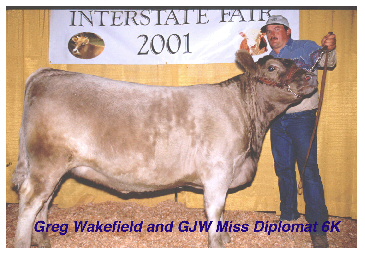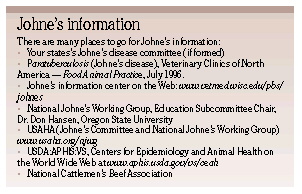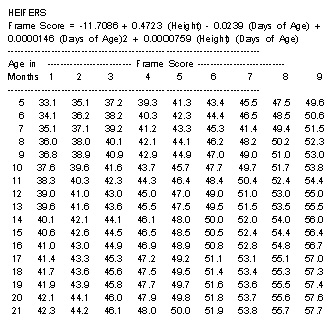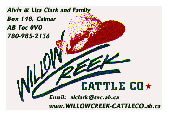The NWMGA NEWS is a newsletter mailed out quarterly to members of the Northwest Murray Grey Association.
Meet Justin Holloway
At age 25, Justin Holloway is currently the youngest member of the NWMGA Board of Directors. He may well be the youngest ever! But don�t be concerned over his early commitment to service. After all, he started his own herd of cattle at age nine.
Justin has had a wide area of experience with various breeds of cattle. Over his 16 years in the cattle business, he has used registered Angus, Shorthorns, Herefords, Simmentals and crossbreds. He settled on the Murray Grey about three years ago. Why Murray Greys? Justin supports his wife MaryAnn and there 16 month old daughter, Kaylie by trimming hooves and AI�ing cattle. Doing AI work for Genex Corporation he had the opportunity to see just how well the Murray Grey influenced various breeds of cattle. He even tried some on his Simmentals. When he saw the calves, the rest is history.
Justin has found what many others are finding out about the Murray Grey. He says they are not extreme! They just do what they need to do and do it well. They breed back every year. They produce a quality calf. The cows milk well. The carcass is excellent. The mothers are very protective. And don�t forget that docile temperament.
Justin met his bride-to-be over Christmas break at Kinghorn Elementary school where his father was a teacher. It just so happened that another teacher there had a nice daughter that caught his eye. Her name was MaryAnn. They soon found that they had both made previous plans to enter the animal science program at Ricks College in Rexburg, Idaho. After graduation they were married. A couple years later, along came Kaylie.
Justin and MaryAnn were able to purchase their first dozen Murray Greys from Kim Rolfe. They have picked a few more here and there and rely heavily on Justin�s AI supply. They share a ranch with MaryAnn�s father, LaRalph Christensen. Future plans call for a Murray Grey herd between one and two hundred head and their own place to work them. Given the progress the Holloway�s have made in just the last few years, I would suppose that goal isn�t too far off.
The next time you happen across a Northwest Murray Grey function, or if you get around Idaho Falls, just give Justin a hearty hello. He is easy to spot. He is �the guy with the kid�! Don�t confuse him with �the old guy with the kid�!
![]()
AMGA National Show
2003 National Murray Grey Show to be held in Spokane!
The American Murray Grey Association National Show of AMGA and CMGA registered cattle will be sponsored by the Northwest Murray Grey Association this year. It will be held in Spokane, Washington at the Spokane County Interstate Fair.
Sept 10th Cattle in barns.
Sept 11th 7:30 PM NWMGA general meeting
Sept 12th 8:00 AM Heifer Futurity Show
Sept 12th 2:00 PM AMGA Directors Meeting
Sept 12th 7:30 PM AMGA General Meeting
Sept 13th 10:00 AM National Show & Heifer Raffle
Sept 13th 7:00 PM Awards Banquet & Silent Auction
![]()
Top
Heifer Futurity |
 |
This was the second year of the Heifer Futurity. Most of the heifers shown as calves were back again. A criteria was that they had to return bred. Next year, they will be show with calves at side. This program emphasizes the maternal traits of the Murray Grey breed. Points accumulate over the three-year period. Based on age, these heifers are broken into two classes. This years results are:
Champion: GJW Miss Diplomat 6K owned by Wakefield Murray Greys (Pictured)
Reserve Champion: Twin Fir Katerina owned by M&M Ranch
3rd Overall: Noble Kitani 28K owned by Damn Farm
4th Overall: 09 Jade K 168 owned by 09 Ranch (John Thomson)
Other animals who placed in the classes were: Bar 4J Kimbra 42K from Bar 4J Holdings, Twin Fir Silky owned by Twin Fir Farms, Willowcreek Temar's Destiny owned by Megan Clark, Bar 4J Keimo 435K owned by Bar 4J Holdings, 09 Jade K172 owned by 09 Ranch and Willowcreek Fancy Free owned by Willow Creek Cattle Company.
![]()
Jr. Showman Tries Murray Greys
I started showing a year ago. The first heifer I showed was a black Brangus, named Rodeo. I went to Be-A-Champ Show Camp to learn how to groom and show cattle. Before I went to this camp I had never even touched a cow. With my heifer last year I made first place and reserve grand champion at Ouachita county fair, I got last place at Pine Bluff District Fair, and when I went to the Arkansas State Fair my heifer stepped on my foot and broke two of my toes.
This year I had another crossbred heifer. She was 1/2 Brangus, and I wasn't sure what her mother was. I only took her to three shows because I got her at the beginning of the summer, and couldn't take her to the spring shows.
When I took Volley, my heifer, up to the vet to get her health papers, he told me she looked exactly like a Murray Grey. I had never heard of this breed before, so when we came home we looked it up on the internet and sure enough she looked just like one.
So I asked the people we got her from Bo and Marianna Hunter, some neighbors of ours, what her Mother was and sure enough here mom had Murray Grey in her background.

Now I plan to breed her to a Murray Grey bull. I would like to use a black Murray Grey bull because all the animals who beat Volley in competition were black. We have someone who will AI Volley this fall. This way I can show her calf also. I plan on doing very well next year considering how well I did this year. At county fair I made first and grand champion, at district I made first, and at state I made fourth. Next year I plan on showing her and her calf as a cow and calf pair, and I hope to show a steer also.
| Ouachita County Fair - First Place & Grand Champion | |
| Pine Bluff District Fair - First Place | |
| Arkansas State Fair - Fourth Place |
![]()
What Color Really?
When it is time to register my animals, I am sometimes puzzled by what color designation to use. Is that calf really a dark silver or is it a light dunn? That calf is really light but does that mean it is "L" for white (light silver) or is it really a silver? Worse yet, is it really black or actually "D" for dark/dunn. This last dilemma is not helped by the fact that the Australians don't register animals as black animals but generally call them dark on the registration papers.
The first step in this process is to outline the four designation choices on your registration forms.
Calves typically lighten as they get older. I have made the mistake of thinking of a calf as a dunn only to find that it becomes a silver by the time it is six-months old. Predicting the final color correctly usually means that borderline calves get the lighter designation.
![]()
AMGA
If you need forms, Breeder's Handbook, or to send in registration papers, please contact the American Murray Grey Association at:
American Murray Grey Association
The web site is in the process of being revamped and will hopefully provide a good source of information and interest for the breed.
As mentioned, with the addition of both a Performance and a Pedigree registry, some fees have been modified. Breeders will need to select one or the other registration options.
Don't forget to send in your performance data for 205 and 365 weights. 2002 calves will have the "M" designation.
![]()
AMGA Offers Options
At the AMGA Directors meeting on October 20, 2001, it was decided to offer a choice of registration options to AMGA members. Beginning immediately, AMGA members may participate in either the Performance Registry or the Pedigree Registry.
Those AMGA members interested solely in registering show animals can opt to obtain certification of Pedigree only on their registration papers for a particular animal. Those who want Performance information and are willing to record and submit the necessary data will still receive those scores.
New fees were instituted which were listed in the AMGA News and may also be received by contacting AMGA directly.
![]()
Johnes Disease in Beef Herds |
|
Submitted Article by Hillside Acres |
Johne's disease is of particular importance to purebred and registered herds of all breeds. "Johne's disease has a direct impact on people selling genetics," says Don Hansen, DVM, Oregon State University. "I think it's a disease that should not be sold and I don't think anyone will disagree. It's definitely an issue for seedstock and purebred producers."
Johne's disease, or Paratuberculosis, is a chronic mycobacterial infection affecting primarily the lower small intestine of many ruminants. Infections have been found in cattle, sheep, goats, llamas and some species of non-domestic ruminants (deer, bison).
The Beef `97 Study conducted by the USDA's National Animal Health Monitoring System showed that 92.2% of beef producers were either unaware of Johne's disease or recognized the name but knew little else about it, regardless of the size of the operation or region. The study also showed the 7.9% of 380 herds tested had animals positive for Johne's using the ELISA test.
Johne's disease usually refers to the clinical condition associated with infection from the organism Mycobacterium Paratuberculosis. The organism lives in the intestinal cells and lymph nodes, where it causes progressive thickening of the bowel wall of the lower small intestine and upper large intestine. Infection sometimes extends to the lower large bowel and rectum. The organism is passed out in feces and easily survives in manure and stagnant pond water for a year or more.
New infections usually occur when young calves are exposed to the contaminated environment and ingest the organism by licking or sucking the dam's udder or vulval area. Infections also occur when young calves come in contact with dirty infected bedding in calving areas. Calves can also become infected while in the uterus of a positive cow, or they can ingest bacteria which can be passed in the colostrum or milk. The risk of any of these three routes of infection is higher as the cow enters more advanced stages of the disease.
After infection, the bacteria grow slowly in the intestinal cells and cause a gradual thickening of the intestinal wall. These changes keep the intestine from doing its job, resulting in weight loss and diarrhea.
There are four Stages of Johne's Disease in Cattle.
Stage I - Silent, subclinical, non-detectable infection - typically this stage occurs in calves, and heifers or bulls less than two years of age or animals exposed to a small dose of bacteria. There are currently no tests on the market to detect or identify these animals. Eventually, these animals progress to Stage II.
Stage II - Subclinical shedders typically involving older animals in the 3-6 year range. These animals may appear healthy, but are shedding enough M. paratuberculosis organisms in their manure to be detected on fecal culture. By shedding organisms, these animals are contaminating the environment. Blood testing, ELISA, may or may not be reliable in detecting these animals.
Stage III - Clinical Johne's disease - any animal with advanced infection, which may have been brought on by a period of stress. These cattle have acute or intermittent, watery, fluid manure. A loss of weight and a drop in milk production are also common signs. Many of these animals continue to eat, and are positive on serologic tests. Signs may last from a few days to a few weeks before these animals progress on to Stage IV.
Stage IV - Advanced Clinical Johne's Disease - This is the end stage of this disease. Most animals are very thin with fluid diarrhea. Some animals can progress from Stage II to Stage IV in a few weeks.
There are currently only two reliable tests to detect the presence of M. Paratuberculosis. One is a simple blood test called an ELISA test. It can be used for a quick result usually in a few days. The other and most reliable is a fecal culture. It is the cheapest, $6.00 in Oregon, but can take up to 3 months to develop. The ELISA test is currently the one that USDA is considering requiring for all cattle imported to the US.
The University of Wisconsin Madison has been at the forefront of the Johnes battle here in the US. Dr. Mike Collins, DVM, Ph.D. maintains a website with all the pertinent information on this disease http://www.johnes.org/
Johnes can be introduced to the herd via infected rented herd bulls or purchased animals that may be infected from birth. There are several states offering Johnes testing programs in an effort to eliminate the disease from beef herds across the US.
Hillside Acres is currently in the third year of a Johnes pilot program sponsored by the Oregon State University under the direction of Dr. Don Hansen. It is his intention to make this program available to all interested beef producers in Oregon and other states as well. The cost of testing, roughly $10.00 / head in most states, is far less than the cost of dealing with the infection after it gets established in a herd.

![]()
Featured Ranch |
|
Willow Creek Cattle Company |
Editor's Note: Each newsletter we feature a Murray Grey Ranch. This quarter, we have selected Willowcreek Cattle Company run by Alvin and Lisa Clark and their daughters.
We, at Willow Creek Cattle Company raise quality cattle and young-uns here in Calmar, Alberta, Canada. We are active in 4-H, and the Canadian and Northwest Murray Grey Associations. Our girls Meghan, Alyssa, Breanna, and Kelsey are all qualified ranch hands. We home school our girls and this gives us the freedom to travel and show cattle throughout the US and Canada.
At Willow Creek Cattle Company we strive to maintain quality in our breeding program with strong emphasis in raising cattle that meet today's commercial cattlemen's requirements and consumer demand. We would say that we have had moovalous success.
Willow Creek Cattle Company owns a quarter (160 acres) and leases another quarter plus 60 acres. This is devoted mostly to Murray Greys and a few commercial cattle.
Alvin bought his first Murray Grey in 1973 as a 4-H project in Ontario. After moving to Alberta in 1980, and meeting Lisa, he fell in love with the west (and with Lisa, presumably) and decided to stay. In 1985 we bought the farm at Calmar and were hooked on the country life.
We began our herd with 30 purebred Murray Grey and now run approximately 100 head.
Willowcreek Cattle Co attends a number of shows throughout Canada and the US. This year we have attended, among others, the Calgary Stampede-Calgary Alberta, Olds County Fair-Olds Alberta, Spokane Interstate Fair-Spokane WA, and Farm Fair International-Edmonton Alberta, Focus on 4H-Edmonton, Bashaw Provincial Heifer Show - Bashaw, 4H Achievement Day with Calmar Heart of the Country 4H club.
Willow Creek Cattle Co. is registered with BREEDPLAN in Australia. Breed Plan is a modern genetic performance evaluation system for beef cattle breeders. We believe that Breedplan offers breeders the potential to accelerate genetic performance in your herd, tighten up your breeding operations and improve productivity.
Because we place serious focus on quality breeding animals, we sell a lot of cattle to Murray Grey breeders. We also market to local cattle people and at the Murray Grey Spring Spectacular Sale at Bull and Female sale at Red Deer, Alberta. This is a consignment sale from Murray Grey breeders in Alberta. This year, we sold seven at this sale
We AI about 75% of our cows. Use a variety of semen. Alvin learned alot in Australia and takes a strong interest in bringing in high-quality Murray Grey semen from outstanding Australian bulls.
From the girls' perspective, they like to show Murray Greys due to their quiet, calm temperament. They also find that competing with Murray Greys is sure to bring home the ribbons.
Feel free to call us anytime for information about our cattle or the Murray Grey Breed.
Postal address Box 148, Calmar, Alberta Canada T0C 0V0
Email [email protected]
![]()
| Top | |
Where's the Beef?In Australia, Mate! |
 |
Reprinted from the Christian Science Monitor
Cameron Rasheed is steering his SUV across White Hole Pad-dock toward a spot of green on a horizon otherwise dominated by the golden glow of acre after acre of sun-dried grass.
Finches dart out by the dozen and the occasional sleepy kangaroo eyes him cu-riously, as little brown dots slowly emerge from the green and come into focus.
Finally, Mr. Rasheed arrives at the edge of what turns out to be a fertile lakebed carpeted with high-protein "blue grass." "If I were a cow, this is where I'd be," declares the soft spoken assistant manager of Brunette Downs, a 3-million-acre cattle station in Australia's Northern Territory.
From Europe to South America, the world's cattle industry has been hit hard in the past year, as out-breaks of foot-and-mouth disease followed concerns over so-called mad cow disease.
But Australia has been free of such problems, and - after tough times in the1990s - cattle farmers here now are enjoying what analysts say is the best season in more than three decades.
Australian cattle prices are up 40 per-cent this year alone. It's a profitable time to own part of the 28-million-strong herd that underlies Australia's long-standing place as the world's top beef exporter, providing some 22 percent of the global export market.
"These are very buoyant times," says Peter Weeks, chief analyst for Meat and Livestock Australia, an industry body.
Even with talk of recession in its two key markets - Japan and the US together buy about 75 percent of Australia's annual beef exports - Mr. Weeks says that Australian cattle farmers are exporting record numbers of cattle at record prices.
Foreign buyers have come in droves to buy cheap meat, attracted by a weak Australian dollar. This is happening at a time when consumer demand has risen in the US and other developed countries. Combine that with reduced competition from European and South American producers as a result of foot-and-mouth outbreaks, along with back-to-back plentiful rainy seasons in Australia's often-arid north-ern regions, and it all sounds like a cattleman's dream.
But Weeks cautions that the Australian dollar could rise and disease might hit Australia. Still, some in the industry think the good times are here to stay. Peter Holmes � Court, chief executive of the Australian Agricultural Company, Australia's second-largest cattle company and the owner of Brunette Downs, argues that the country's reputation for "clean," or "disease-free," beef will help extend the good run.
"Thirty percent of the world's `clean' beef has been removed from world mar-kets," he says. "If we're standing in Aus-tralia, 30 percent of our competitors in a lot of markets are gone." Mr. Holmes � Court is so convinced of the good times ahead that he is working to increase the Australian Agricultural Company's herd from 400,000 head of cattle to a million by 2006, which would make it the world's largest cattle company.
But then, the Australian cattle industry has always been unique because of its scale. Visit any of its large cattle ranches, called "stations," and you encounter daunting numbers.
Brunette Downs, by no means the largest of Australia's stations, is home to almost 70,000 head of cattle. When Rasheed goes out to check on them, it's often by plane, from one of 18 airstrips on the property. Roundups are often done by helicopter.
The latest rainy season has left the station with a 770-square mile lake, full for the first time since the mid-1970s.
Ben Wratten, one of the station's head stockmen (cowboys) has just returned from the lake area, checking on a group of cattle stranded by floodwaters since March. After finding them feeding on that prized "blue grass," Mr. Wratten says, with pride, "There's nothing better than the sight of fat, healthy cattle."
Indeed, for Australia's cattle producers too - after lean years last decade - there's nothing better than the fat and healthy times now.
![]()
Frame Scores
Frame scores are an objective, numerical description of cattle skeletal size which reflect the growth pattern and potential mature size of an animal. Frame score values typically range from 2 to 9 and are calculated from hip height and age. Frame scores are frequently reported as supplementary information to weight and other performance data. They can be used to project mature size, provide an indication of composition, and characterize performance potential and nutritional requirements of an animal.
Considerable variation exists among cattle for frame size. Optimum frame score and desired body type will be different among production situations which differ in feed resources, breeding systems, and market endpoints. Low frame scores are descriptive of cattle which are short in stature for their age, tend to be early maturing, and finish for slaughter and mature at lighter body weights. High frame scores are indicative of cattle that are tall for their age, have a slower rate of maturity, and finish and mature at relatively heavy body weights. Rate of gain is usually higher for larger framed cattle; however, large differences in rate and efficiency of gain exist in cattle of similar size.
For cattle developed under a consistent and adequate plane of nutrition for normal growth, a calculated frame score should be similar regardless of when the animal was measured. Theoretically an animal should have the same frame score throughout its life. Inconsistent environmental factors and management can alter skeletal growth rate, which may result in cattle developing slightly faster or slower than anticipated. As a result animals may increase or decrease a frame score over time depending on rate of growth.
The Beef Improvement Federation has recommended in its "Guidelines for Uniform Beef Improvement Programs" that height measurements for the calculation of frame score be taken at the hip directly over the hook bones. Height measurements can be collected through the use of hip height measuring sticks marketed specifically for that purpose. For accurate height measurements it is necessary for the animal to have its legs set squarely and head in a normal position. An alternative to using a height stick and where the accuracy of individual measurements is not as critical is to place a grid marked in height increments inside a scale or working chute. As cattle are being worked, a height can be read off the grid by sighting across the animal's hip. Modifications can also be made to equip cattle handling chutes with a moveable front to back pull-down measuring device calibrated to obtain height measurements.
Beef Improvement Federation recommended procedures are available to adjust actual height measurements to standard performance testing 205-day weaning and 365-day yearling stages. Hip heights adjusted to 205 days should be collected between 160 and 250 days of age similar to the range for calculating adjusted weaning weights. Cattle should be at least 330 days of age for predicting yearling height measurements that are adjusted to 365 days.
Age of calf and age of dam adjustment factors and formulas for calculating adjusted 205-day and 365-day hip heights are presented in Table 1. As an example of adjusting an actual height, the 205-day weaning height of a bull calf born March 1 to a 4-year-old dam and weaned October 10 measuring 44 inches would be 43.4 inches. {44 + [(205 - 224) * .033]} * 1.01 = 43.4
Adjustment Factors and Formulas
Adjusted Height = {actual height + [(205 - actual age)* age of calf adjustment]} * age of dam adjustment
|
TABLE 1. Factors for 205 Height |
||
|
|
||
|
|
||
|
|
||
|
|
Adjusted Height = {actual height + [(365 - actual age)* age of calf adjustment]}
TABLE 2. Factors for 365 Height
|
|
||
|
|
||
|
|
||
|
|
Source: BIF Guidelines for Uniform Beef Improvement Programs, 1990
A hip height measurement can be converted to a frame score if the animal's age is known. Frame scores can be approximated from "height for age" frame score tables or calculated by mathematical formulas. Separate charts and formulas exist for bulls and heifers due to differing rates of skeletal growth between sexes. As an example of determining a frame score, a bull measuring 48 inches at 330 days of age would be estimated to be about a frame score 5 from the chart or calculated to have a frame score of 4.98 by the formula. [-11.548 + (.4878 * 48) - (.0289 * 330) + (.0000947 * 330 * 330) + (.0000334 * 48 * 330)] = 4.98.
Several beef cattle breed associations have developed their own frame score formulas and charts which are based on average growth and development within their specific breed and vary slightly from BIF calculations.
Frame score provides an indication of an animal's growth curve, which can be used to project expected finishing weight for slaughter cattle, or mature weight for breeding cattle. Table 3 provides an estimate of mature cow weight and expected slaughter weight at finish for steers and heifers by frame score. These projections are for average cattle; actual weights will also vary due to differences in muscling, body length, condition and other factors.
Greater mature cow weight is associated with increased frame scores, which results in additional feed required for maintenance because of a larger body mass. Stocking rates and quantities of feed need to be adjusted to meet the demands of larger cows. Provided necessary feed is available, larger cows generally meet their higher requirements. Under favorable management, reproductive rates tend to be similar across frame size; however, when the availability of feed becomes restricted, larger framed cattle are more susceptible to reproductive failure. Increasing mature size is a concern and may require adjusting replacement heifer development programs in order to insure they reach heavier prebreeding weights necessary to attain puberty.
Large frame size is also associated with greater growth potential, longer finishing periods, and heavier slaughter weights. The generally preferred range for carcass weights of 650 to 850 pounds suggests the need to produce feeder cattle with a 5 to 7 range in frame scores. The current USDA feeder cattle grading system is based on the factors of frame size and muscle thickness. Three frame score designations are included: large, medium, and small, which relate to an evaluation by appearance of an animal's skeletal height in relation to its age and the weight at which an animal will produce a choice quality carcass with about.5 inches external fat at the 12th rib. Large frame steers and heifers would not be expected to produce choice carcasses until their live weight exceeds 1200 and 1000 pounds, respectively. Medium frame steers would be expected to produce choice carcasses at live weights of 1000 to 1200 pounds, and heifers at 850 to 1000 pounds. Small frame steers and heifers would produce choice carcasses at live weights of less than 1000 and 850 pounds, respectively.
An indication of frame size is very important when estimating growing and finishing cattle nutrient requirements and projected feed intake. Although larger framed cattle will generally have increased intakes, energy concentration in the feed that is used for gain is lower than that of medium framed cattle. Furthermore, protein requirements for large framed steers have been based on medium framed steers that weigh 15% less. This results in a greater protein requirement for large compared to medium framed cattle.
Frame score is considered to be moderately to highly heritable. As such, frame score can be significantly changed through selection, primarily achieved through sire selection. With an heritability estimate of .40, about 40% of a bull's difference in frame score from herd average will be passed on to progeny.
Frame score measurements are descriptive of animal type and growth patterns in beef cattle. They are useful in evaluating animal nutritional requirements, characterizing target market weights, and aid in selection decisions.
 |
 |
![]()
Top
Submissions
Featured Ranch
Each newsletter, we have a featured ranch profile. If you would like your ranch/farm profiled, please send a synopsis of your operation including, but not limited to, the following: focus (purebred, cross, commercial), target market (breeders, commercial, 4H, etc.), goals, how long you have been raising Murray Greys, number of animals you run, challenges you encounter, etc. This should be provided to the address above.
Submitted Articles and Letters
Any article which you feel would be useful or interesting to NWMGA members can be submitted to the address above. In exchange, you will receive a FREE BUSINESS CARD-SIZED AD, if we print the article (and we are very flexible but may make some editorial changes). When you send your article, please provide the ad copy (electronically, faxed or mailed.)
![]()
Advertising rates
If you have ad copy, please provide that. If not, and you wish an ad, please describe the ad you desire and we will make it up for you. Ads are to be send to electronically (preferred), faxed or mailed to the following address:
The NWMGA
News
George Virtue, Editor
29449 Berlin Rd.
Sweet Home,
OR 97386
Email:
[email protected]
Phone: 541-367-5751

